Where to Visit
Museums
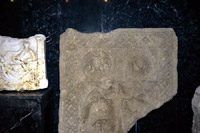 Tarsus Museum
Tarsus Museum
Pieces of arts, which are exhibited in Historical Kubat Paşa Theology School, are transferred into Museum Section of the 75th Year Culture Center on 2000. Beginning from Neolithic Age, rock pieces of arts, which belong to Roman, Bizantium and Ottoman periods, Roman and Byzantium coins, baked soil pots, metallic materials are exhibiting.
Museum Tel: (+90 324) 613 18 65- 613 10 43
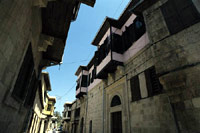 Hıstorıcal Tarsus Houses
Hıstorıcal Tarsus Houses
It is possible to see the evidences of historical accumulation of Tarsus, when you step into province. It is showing the historical pieces of arts exposing architectural differences and modesty within typical Mediterranean house tradition. In all of the houses made up of two layered by adobe, rock and wood, wooden and handicraft steel adornments are completing the rock doors.
Ancıent Cıtıes And Hıstorıcal Ruıns
Cleopatra Gate
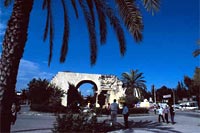 Cleopatra Gate, which is at the west part of the Tarsus and on Mersin road, is the only antic city gate, which stands still today. It is mentioned that Egypt's famous Queen Cleopatra had come via ships to meet with Roman General, Antonius in 41 B. C., and welcome with ceremonies at Gözlükule Tumulus, and they had entered to city from the sea gate of that day. Ramparts, which has three gates, composed of Bağ, Sea and Adana, surrounding city from its three sides had been constructed instead of this gate which had collapsed during following years.
Cleopatra Gate, which is at the west part of the Tarsus and on Mersin road, is the only antic city gate, which stands still today. It is mentioned that Egypt's famous Queen Cleopatra had come via ships to meet with Roman General, Antonius in 41 B. C., and welcome with ceremonies at Gözlükule Tumulus, and they had entered to city from the sea gate of that day. Ramparts, which has three gates, composed of Bağ, Sea and Adana, surrounding city from its three sides had been constructed instead of this gate which had collapsed during following years.
Onur (Independence) Script (Tarsus Inscription)
The script, is on the wall of Yeni Hamam, is placed just at the north of Cleopatra Gate. It is dated to Roman Emperor, Severus Alexander (222 - 235 A. D.) Period. It is used as a pedestal of a statue during Romans.
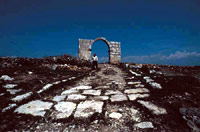
Roman Road
Roman Road, is located at the upper part of Sağlıklı Village, which is 15 km. away from Tarsus. Width of Roman Road varies between 2.94 and 3.00 meters here. This historical silk road's undamaged parts length is about 3 km.
Hippodrome
While Tarsus was living its one of the most marvelous periods during Romans, it was also a sports center of its environment. Hippodrome, which is near to American College and in which various sports competitions were organized during that period, has a historical importance due to this reason.
Gözlü Kule Tumulus
It is a tumulus, which is 300 m. long and 22 m. high, and afforest as a park today, in Ulu Cami province at south east of the city.
During the scientific excavation studies, begun after 1934, 33 cultural layer had been determined from Early Neolitic to Islamic periods:
National Kilikya, Mesopotamia and Miken ceramics, rock based adobe walls, houses and narrow streets, belong to Ancient Bronze Age, layers, belong to Late Bronze Age, a big temple ruin, showing temple characteristics in Hattuşaş, Hieroglyph and nail written seal and titles, early Period structural complexes, Cyprus based ceramic vases, Asurian Period's tablets, baked soil seals, ceramics are found within layers. Ruins of bronze working and processing workshop had been revealed in findings, belongs to the 4th century B. C. Bizantium Period.
Republic Area and Antic Road
It is at the center of Tarsus, 150 m. south west of St. Paul Well. It is thought that this antic road is constructed by Romans during the Ist century B. C. Ground of the street although in spite of the corrosions occurred by time, had mostly preserved its antic period appearance during Antic Age. Wheel signs, which are seen time to time is evidencing that road is used for internal city transportation, one of its main functions, at the same time. There is a 3 staged podium (stylobat) at north east direction of the street.
A rectangular shaped chamber of House with Mosaic Courtyard, at south west side of the excavation site, is revealed during studies. At the middle of the courtyard, a pool ruin is found. Pool is covered with colored marble plates. Other parts of the courtyard is covered with mosaic.
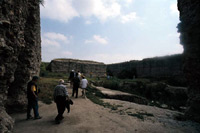
Donuktaş (Roman Temple)
Donuktaş, which has reached today, is the oldest temple in the Tekke District, at the east of Tarsus, Although there is no information about god, to which this temple is constructed, structure is described as monument of Asur King, Sardanapal by one of the Medieval wanderers, V. Longlois.
Bac Bridge (Jüstinyen Bridge)
This rock bridge, at the Tarsus entrance of Ankara - Adana road, is constructed during Byzantium Period, 6th century by Justinyen for preventing Berdan (Cydnos) stream of Tarsus from flooding. This three sectioned bridge, on which all vehicles were passing through until to a recent period, is restored in 1978.
St. Paul Well
Well is in a courtyard, known as the place of St. Paul's house for a long time, at approximately 300 m. north of Republic Area in Kızılmurat District. It is known to be constructed in the name of St. Paul.Historically rich background having well and near environment is under conservation today, and detail archeological studies are performed on it. As a result of this researches, St. Paul Well and surrounding place is determined to give Roman, Byzantium and Ottoman Period cultural layers. Tourists, who believe that the water coming from St. Paul Well is curative, are also visiting this place with the aim of hadj.
First one of the 12 disciples of Jesus Christ, St. Paul, is the first theoretician of Christianity, and born in Tarsus. St. Paul, had attached great importance to Tarsus, where he had born.
Waterfall and Roman Graves
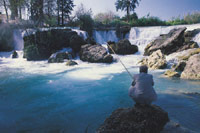 It is known that there is underground graves remaining from Romans at the place where waterfall is present. Today's waterfall is formed with falling of river over 3 - 5 meters high graves as a result of changing the place of bed of Tarsus River. From time to time, graves can be seen due to the changes on the water levels.
It is known that there is underground graves remaining from Romans at the place where waterfall is present. Today's waterfall is formed with falling of river over 3 - 5 meters high graves as a result of changing the place of bed of Tarsus River. From time to time, graves can be seen due to the changes on the water levels.
Waterfall and environment is one of the most attractive places for natives of Tarsus, especially during hot summer days. During spring months, pool and waterfall composes a marvelous view with the sun set with its increasing flow during spring months.Its most important characteristic is rapid reach of feeding sources to waterfall. This condition is maintaining to remain water always cool. It is serving to foreign and native all persons with its tea gardens and restaurants.
Eshab-ı Kehf Cavern
It is 12 km. north of Tarsus, near to Ulaş Village. This cavern, which gives its name to section of the Koran, is esteemed as holy by Moslems and Christians.
Story of Eshab-ı Kehf Cavern is very impressive; during polytheist age, seven juveniles (Yemliha, Mekseline, Mislina, Mernuş, Sazenuş, Debrenuş and Kefeştetayuş), who had escaped from torments as they believe to monotheism, had hidden in this cavern together with their dogs. Miraculously rock is cut and these faithful persons had slept for 300 years, and had seen that everything is different when they had waken up. One of them had gone to the city for buying food and seized. When arrested person come to cavern with him, he did not see anything rather than a nest on which seven young birds had been perched. For this reason, here is also known as "Seven Sleepers Cavern". Mosque, constructed by Sultan Abdüllaziz on the caverns, had been added a minaret with three balconies.
Gülek Strait and Castle
Gülek Strait, which is 62 km. away from Tarsus, is also known as Kilikya Gate during ancient times. İbrahim Paşa, who was voyaging to Anatolia in 1833, had widened the very narrow strait for passing his gunneries. You can reach to the castle with an approximately 3 - 4 km. distance on forest road from Gülek Borough.
This is an appropriate place for trekking.
Mosques, Churches And Theology Schools
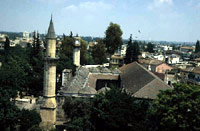 Ulu Mosque
Ulu Mosque
Mosque, which named the district at south of city, is constructed by Ramazanoğlu Ruler, Piri Paşa's son, İbrahim Bey in 1579. In the tomb at east part of Mosque, Şit and Lokman Prophet as well as Abbasi caliph, Ma'mun's grave is present.
Makam-ı Şerif Mosque
It is believed that grave of Danyal prophet is in the mosque, which named the district at north west of theology school. The most important characteristic of the mosque, is being the only prophet tomb in Türkiye, which was constructed in 1857,
Old Mosque (Church Mosque)
This historical structure, which is adjacent to Adana road approximately 100 m. north east of Makam Mosque, is constructed as church, an then it is transformed into mosque in 1415 by Ramazanoğlu Ahmet Bey.
St. Paul Church
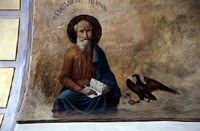 It is thought that structure devoted to St. Paul and in Ulu Mosque District at south of the city, is constructed during the 11th and 12th centuries A. D.
It is thought that structure devoted to St. Paul and in Ulu Mosque District at south of the city, is constructed during the 11th and 12th centuries A. D.
Although it had begun to be protected in 1993, and tried to open as a Monument Museum, church internal and external place restoration works are continuing gradually.
There is bell tower at north east edge of the church. At the center of the ceiling, there are frisks of Jesus Christ, Yohannes, Mattios, Marcos and Lucas. A panorama and angle descriptions are present at both sides of the glass, in the center naphtha. There is a wooden suspended layer, supported by first two columns on the west internal place and entrance. Panorama pictures can be seen on the banisters of this central layer.
In 1992 and 1993, Vatican had organized "St. Paul Symposium and Ceremony" in St. Paul Church. Christians, are visiting St. Paul Monument Museum regularly with the aim of hadj.
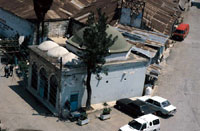 Bilal-i Habeş Small Mosque
Bilal-i Habeş Small Mosque
Small mosque at south end of the road at Beyaz Bazaar, is believed that it is constructed on the place where Hz. Muhammed's muezzin, Bilal-i Habeşi had recited the azan and performed the ritual prayers of Islam devoted to his name.
Kubad Paşa Theology School
It is known that Tarsus is not only an agricultural and commercial center, but also one of the most important cultural and education centers. Theology school, which is constructed by Ramazanoğlu Ruler, Kubad Paşa in 1550s, is the only educational institute, which could reach today from ancient times. This structure, which had the traditional Seljukan architecture, is constructed of smooth cut rock.
Building is generally restored in 1969 and 1970, and begun to be used as a museum by Ministry of Culture in 1971. Due to repair and insufficiency of the structure, pieces of arts which belong to museum are transferred to new building in 75th Year Cultural Center.
Inns, Hamams Nad Bazaars
Altından Geçme (Roman Hamam)
This structure which reflects the greatness of Roman Empire Age in Tarsus, but very damaged till today is a Roman Hamam ruin.
Şahmeran Hamam (Old Hamam)
Old hamam, which is adjacent to Vakıf Commercial Building, is constructed by Ramazanoğulları on a pedestal remaining from Romans. It has the characteristics of a Turkish Hamam according to its plan shape and sizes. Structure with 4 eyvans, entered into service with restoring today, is composed of heat and private cabinet parts. It is rumored that legendary Şahmeran is killed within this hamam. For this reason, Old Hamam is also known as "Şahmeran Hamam".
New Hamam
It is known that hamam at north east of Ulu Mosque is also belong to Ramazanoğulları Period; and extensively repaired in 1785. Hamam, which has the characteristics of classic Turkish hamams is composed of undressing places, tepidity and temperature parts as well as private cabinets.
Kırk Kaşık Bedesten (White Bazaar)
It is a structuıre which dated with the same periods of mosque, at west of Ulu Mosque. It is the only sample which continues its functions in Tarsus, at junction point of roads and has active commercial life for all periods. Shops are lined at both sides of the corridor covered with very wide and domes within the rectangular planned bedesten.